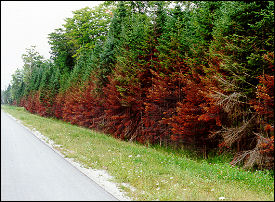With the recent snow and ice storm that hit the Penn State area over the weekend, I have observed the over and under use of anti-slip substances on walkways and roads. I have found that Penn State uses calcium chloride as the main ice melting method. Calcium chloride is very useful for this, as its effectiveness can be explained in simple chemistry terms. The “Van’t Hoff Factor” is a measurement of how solutes impact different properties of a solution. In terms of calcium chloride’s effectiveness on melting ice, the key property that is being changed in freezing point. As the water in the ice interacts with calcium chloride, the atoms mix and reach equilibrium. Due to the fact that calcium chloride causes water to freeze at the lower temperature, the ice melts.
However, the usage of calcium chloride, and any other type of melting salts, have negative impacts on the environment. At some point, the snow will eventually melt. Unfortunately, the melting solution will not be pure water, but it will be an aqueous solution containing the salts. As this solution floods into drains, runs downstream in rivers, and gets absorbed by plants, the environment suffers from the extra solutes. According to the Minnesota Stormwater Manual, the solutes negatively impact the soil health and pollute groundwater. This is eventually shown through physical objects like trees, as seen in the image below.

Effect of chloride on roadside trees. Source
Penn State can do its part in reducing the negative impacts on the environment. The first step can be reducing the amount of salt being used. In some areas, I have observed an obscene amount of salt being spread. This is not only unnecessarily harmful to the environment, but it is a waste of money as well. As seen in the image I took below just two days after the storm, piles of salt still remain on the ground.
Excess salt use by Davey Lab. Photo taken: 1/20/20
This scenario brings about an ethical dilemma, as the caution for the environment seems to require a sacrifice for the safety of pedestrians and drivers. According to Hollis Reddington from the University Of Alaska Anchorage, states like Alaska where wild animals roam free near roads that people use, the state government has prohibited the use of salt on roads. A viable and ethically sound solution may be using sand on the roads. Sand seemingly has minimal impact on the environment, and may also be cheaper than salt. However, many articles claim that sand may have its own negatives also, such as being more harmful to the roads than salt.

This is a really interesting post. It makes sense that dissolved salt would harm plants and animals, I simply had never thought about it. I think it’s really important to make people aware of this issue so that they know to advocate for a different solution, like the sand that you mentioned. As always with environmental issues, we have to make some sacrifices to protect the Earth!
I was very intrigued to read this post as I have been noticing the excessive use of salt around campus. It seems like the sidewalks are always completely covered in the bright blue salts and I have recently been wondering what affects that could be having, outside of stopping people from slipping. I didn’t know any of the science behind it, but even from an outside view it seemed like it couldn’t possibly be good, and after reading this post, that has been confirmed.